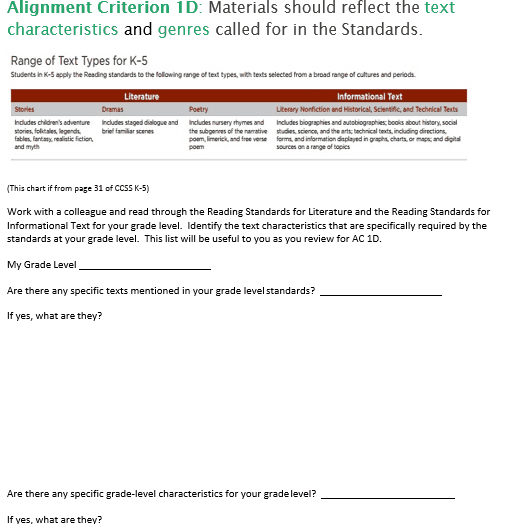Encouraging teachers to make the Shifts toward Common Core-aligned instruction is my daily work as the Common Core Transition Coordinator. Having been charged with the responsibility of planning and facilitating an elementary English Language Arts materials review, I decided to use the opportunity to structure the review training as deep professional learning.
Prior to me taking this position, my district had not anticipated how much time and effort would be needed to support teachers in implementing the Common Core. Luckily, our district hadn’t immediately jumped to purchase new materials as soon as we adopted, so we are not stuck with instructional materials stamped with the CCSS sticker that do not actually align.
I had been working with Student Achievement Partners for more than a year on the Instructional Materials Taskforce so I knew about the Instructional Materials Evaluation Tool (IMET) and where to find helpful resources. I downloaded the Student Achievement Partners’ Instructional Materials Evaluation Tool PD Modules designed for training K-12 reviewers, and tailored them for the teachers I was training.
I made the following adjustments to the modules with my particular K-5 audience in mind:
- Created a handout to help identify text-dependent questions and type of writing that focused on K-5 instead of K-12 to support practice with Alignment Criterion 3A (handout attached below).
The prompts in the handout were pulled from the IMET PD Modules, from teacher-created materials in use in our district, and from our current instructional materials. As the reviewers began to sort the prompts, they quickly noticed that many of the prompts they had authored, and the prompts they knew well from their current instructional materials, were often not as tied to a text as they should be. This juxtaposition of text-based prompts vs. non-text-based prompts provided a vivid illustration of Instructional Shift 2 (reading, writing, and speaking grounded in evidence from text). Using their own prompts, from their own materials, allowed the teachers to practice identifying this important element of Common Core-alignment in a context in which they were already familiar.
- Infused more opportunities to dive deeply into the Standards themselves. I created a note-taking tool (attached below) to go along with Alignment Criterion 1D (text characteristics and genres)
The handout the author created to help educators understand the text requirements in their grades.
Before discussing how we would evaluate materials for Alignment Criterion 1D, I took the opportunity to have grade-level teams read through both the Literature and Informational Text standards to identify the text types required by the standards at their grade level (e.g., drama, poetry, historical texts). It was definitely a “light bulb moment” as teachers and principals saw, for the first time, an element of alignment that they had not previously considered; recognizing the significance for the materials they used each day in their classrooms. I know that previous conversations about our instructional materials not being “aligned” meant, to many, simply that there were not enough informational texts included. With this close look at their grade-level standards, they realized that the alignment holes in our materials went beyond not providing a 50/50 balance of literary and informational text in the K-5 grade band. I heard things like “Read RI3.9. It says ‘compare and contrast the most important points and key details presented in two texts on the same topic.’ Our materials don’t provide pairs of texts like that. I have not been teaching this standard.” By creating the note-taking tool, and asking educators to spend time paying close attention to what each standard called for in their grade, I was able to shed light on a lot of alignment issues within our instructional materials that our teachers and principals didn’t even know existed.
- Included a careful reading of a key section of Appendix A
In my interactions with teachers from across the district I had never been asked about the language standards. I knew that once we hit Alignment Criterion 5 in the IMET training (having to do with language), I would need to slow down and provide intense professional learning on this topic, since it wasn’t something the educators in our group had thought deeply about before. To help introduce them to the Standards’ language requirements, I chose to use the Language section of the Common Core’s Appendix A (the excerpt I used is attached below). With a careful reading of Appendix A, the reviewers could have conversations about the purpose and function of language instruction. Appendix A emphasizes that students need a strong command of grammar so they can make effective language choices while they are speaking and writing. This helps reviewers understand why Alignment Criterion 5C asks reviewers to analyze whether materials include “real-world activities for student practice with natural language.” Because grammar instruction traditionally has looked like a lot of worksheets but very little practice with natural language, the time spent reading Appendix A, and thinking about embedding grammar instruction within natural language, is a worthwhile investment.
When deciding how to customize an IMET training for your own setting I recommend you do the following
- Adjust the examples and non-examples you plan to share reflect the content your audience is familiar with. When I trained a neighboring district I kept the K-12 examples, because I was training K-12 reviewers. In my own district I used only elementary examples and non-examples, because I was working with only K-5 reviewers.
- Adjust the amount of time you will dedicate to different aspects of the training according to the professional learning needs of your audience. IMET training is a golden opportunity for professional learning; don’t pass it up.
- Adjust the amount of background content you include in the training to infuse a focus on the areas where your audience may need additional support.

















